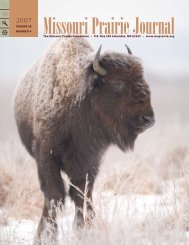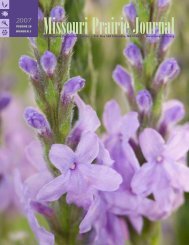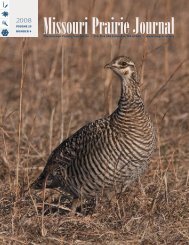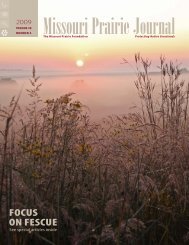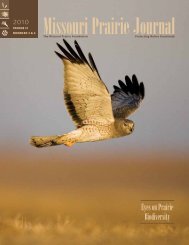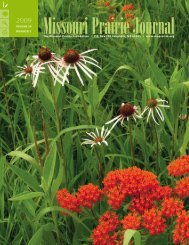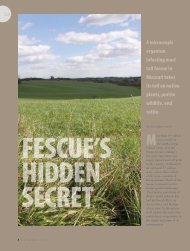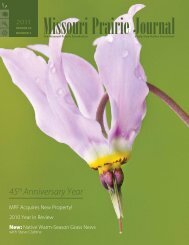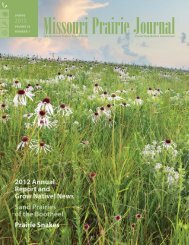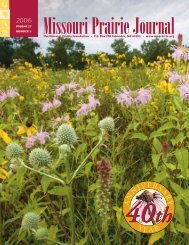Fall & Winter 2012: Volume 33, Numbers 3 & 4 - Missouri Prairie ...
Fall & Winter 2012: Volume 33, Numbers 3 & 4 - Missouri Prairie ...
Fall & Winter 2012: Volume 33, Numbers 3 & 4 - Missouri Prairie ...
Create successful ePaper yourself
Turn your PDF publications into a flip-book with our unique Google optimized e-Paper software.
allow mosquitoes to swarm. We used<br />
glow-sticks and an ever-evolving series<br />
of hand signals to communicate as<br />
we made our final capture approach.<br />
Roughly a third of hens captured in<br />
spring were recaptured during summer<br />
night-lighting annually; about a third of<br />
all capture attempts was successful.<br />
In 2010, small, glue-on transmitters<br />
were placed on summer-captured<br />
juveniles for the first time. Due to<br />
higher-than expected mortality among<br />
translocated juveniles following their<br />
release, the two-phase translocation<br />
process was discontinued. During 2011<br />
and <strong>2012</strong>, all birds were brought to<br />
<strong>Missouri</strong> during spring. Overall, 435<br />
birds were translocated between 2008<br />
and <strong>2012</strong>. Greater prairie-chickens are<br />
relatively short-lived; even on good habitat<br />
most do not survive past two years.<br />
As a result, the offspring of translocated<br />
birds, not the Kansas birds themselves,<br />
comprise the bulk of the population<br />
now residing at and around Wah’Kon-<br />
Tah <strong>Prairie</strong>.<br />
We took a very conservative<br />
approach to trapping individual leks.<br />
No more than 20 percent of males were<br />
removed from a lek in any year, and<br />
we avoided removing dominant males<br />
to help maintain the established social<br />
order on the lek. This required trappers<br />
to tear down and rebuild trap arrays<br />
nearly every day, but this labor-intensive<br />
approach helped assure that counts on<br />
Kansas leks remained stable throughout<br />
the project. We also spread trapping<br />
across a larger area each year to minimize<br />
potential negative impacts to the<br />
Kansas population.<br />
Monitoring Translocated<br />
Birds in <strong>Missouri</strong><br />
Dispersal: Results of translocation projects<br />
conducted by other organizations in<br />
other states indicate that greater prairiechickens<br />
are more likely to disperse from<br />
sites where habitat is dissimilar to that<br />
of their origin, and from sites not occupied<br />
by native birds. We expected some<br />
translocated birds to disperse from the<br />
Wah’Kon-Tah release site.<br />
Greater prairie-chickens translocated by year, sex, and age class.<br />
Year Adult Males Adult Females Juveniles Total<br />
2008 52 24 27 103<br />
2009 50 25 26 101<br />
2010 41 29 18 88<br />
2011 28 53 - 81<br />
<strong>2012</strong> 18 44 - 62<br />
Total 189 175 71 435<br />
NOPPADOL PAOTHONG/MDC<br />
One of six grassland grouse species in<br />
North America, greater prairie-chickens<br />
(Tympanuchus cupido pinnatus) once ranged<br />
throughout native prairies of central<br />
North America from southern Canada to<br />
Texas. Historically, they probably occurred<br />
in 20 states and four Canadian provinces.<br />
However, their distribution has changed<br />
drastically over the past 200 years. Today,<br />
greater prairie-chickens are plentiful<br />
enough to be a game species in Kansas,<br />
Nebraska, and South Dakota, but the birds<br />
are absent from Canada, and only small<br />
populations remain in Wisconsin, Minnesota,<br />
Illinois, Oklahoma, and <strong>Missouri</strong>, where<br />
fewer than 100 individuals native to the<br />
state still survive.<br />
Greater prairie-chicken trapping locations in<br />
the Smoky Hills Region of Kansas. New leks<br />
were trapped each year to assure a conservative<br />
approach. Trapped birds were transported<br />
to Wah’Kon-Tah within six to eight<br />
hours of capture.<br />
Kansas Leks Trapped &<br />
Hen/Chick Capture Locations 2009<br />
Vol. <strong>33</strong> Nos. 3 & 4 <strong>Missouri</strong> <strong>Prairie</strong> Journal 13




